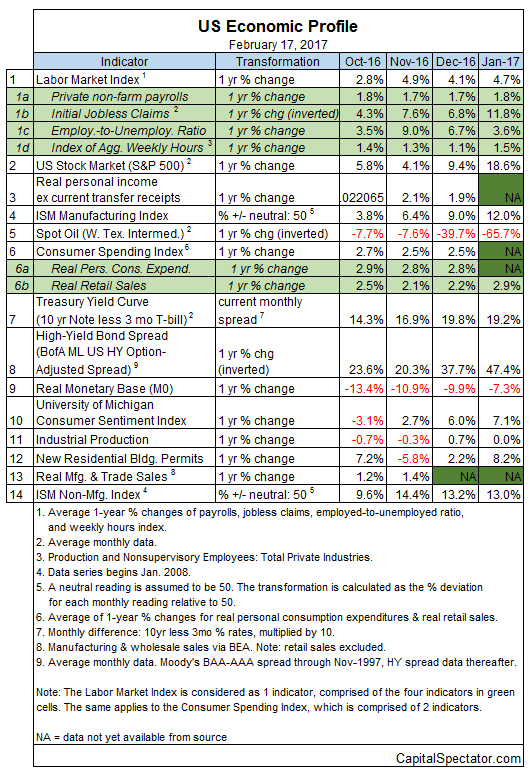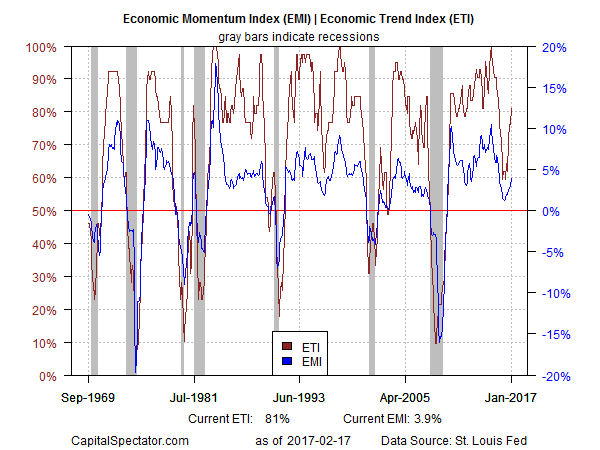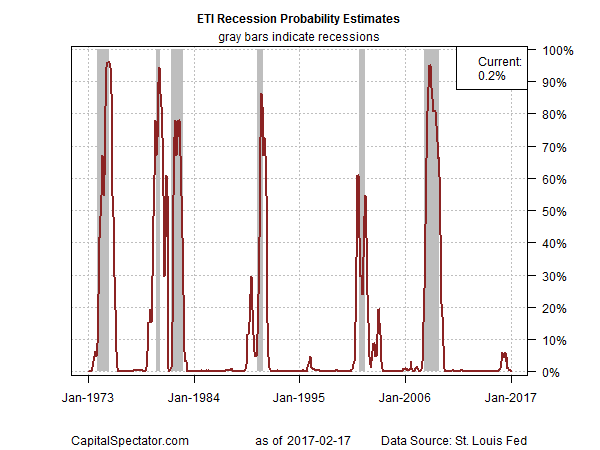Political risk may be on the rise, but the US economy began 2017 on a strong note. As projected in previous months, macro momentum has strengthened, pushing recession risk down to a virtually nil reading for January. Looking ahead, the near-term estimates through next month suggest that the favorable tail wind will continue.
Data published to date from several sources continues to show that an NBER defined recession is nowhere in sight. For example, the latest first-quarter GDP estimate via the Atlanta Fed’s GDPNow model looks modestly encouraging. The bank’s current analysis (as of Feb. 16) anticipates that the economy will expand by 2.4% in the first three months of this year, mildly above the 1.9% rate in last year’s Q4.
Note that some analysts are warning that recession risk is due to rise in this year’s second half. They may or may not be right, but keep in mind that economic predictions that look beyond one or two months into the future are highly speculative. Based on what we now right now, and making conservative projections through next month, offers minimal support for expecting the US economy will slip over to the dark side. The analysis can change, of course, and perhaps quickly, which is why monitoring the incoming data and routinely re-running the analytics is crucial. For the moment, however, the broad trend still looks positive.
Using the numbers in hand, The Capital Spectator’s proprietary business-cycle indexes continue to reflect a low probability that a downturn is imminent. For the nearly complete January profile, only two indicators in our model are signaling weakness: oil prices (via sharply higher prices in year-over-year terms) and a contraction in the monetary base in real terms. Otherwise, a bullish trend prevails. (For a more comprehensive read on business-cycle analysis on a weekly basis, see The US Business Cycle Risk Report.)

Aggregating the data in the table above continues to reflect a broad trend that remains comfortably positive. The Economic Trend and Momentum indices (ETI and EMI, respectively) ticked higher in January, building on a rebound that started in last year’s second half. As a result, both benchmarks remain well above their respective danger zones: 50% for ETI and 0% for EMI. When/if the indexes fall below those tipping points, we’ll have clear warning signs that recession risk is at a critical level, in which case a new downturn is likely. The analysis is based on a methodology outlined in my book on monitoring the business cycle.

Translating ETI’s historical values into recession-risk probabilities via a probit model also points to low business-cycle risk for the US through last month. Analyzing the data with this methodology shows that the numbers continue to imply that the odds are virtually nil that NBER will declare January as the start of a new recession.

For perspective on looking ahead, consider how ETI may evolve as new data is published. One way to project future values for this index is with an econometric technique known as an autoregressive integrated moving average (ARIMA) model, based on calculations via the “forecast” package for R. The ARIMA model calculates the missing data points for each indicator for each month — in this case through March 2017. (Note that November 2016 is currently the latest month with a full set of published data.) Based on today’s projections, ETI is expected to tick lower next month but remain well above its danger zone by staying far above the 50% mark.

Forecasts are always suspect, of course, but recent projections of ETI for the near-term future have proven to be relatively reliable guesstimates vs. the full set of published numbers that followed. That’s not surprising, given ETI’s design to capture the broad trend based on multiple indicators. Predicting individual components, by contrast, is prone to far more uncertainty. The assumption here is that while any one forecast for a given indicator will likely be wrong, the errors may cancel out to some degree by aggregating a broad set of predictions. That’s a reasonable view according to the generally accurate historical record for the ETI forecasts in recent years.
The current projections (the four black dots in the chart above) suggest that the economy will continue to expand. The chart above also includes the range of vintage ETI projections published on these pages in previous months (blue bars), which you can compare with the actual data (red dots) that followed, based on current numbers.
For additional perspective on judging the track record of the forecasts, here are the previous updates for the last three months:
